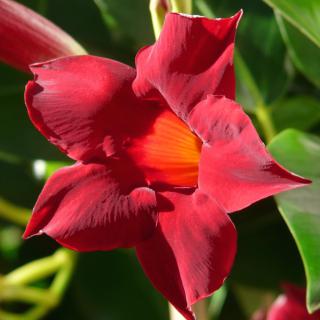

Mandevilla is a remarkable vine. It climbs very high and bears flowers prolifically.
Major Mandevilla facts
Name – Mandevilla species
Family – Apocynceae or dogbane
Type – shrub, climbing vine
Height – 10 feet (3 meters)
Exposure – well-lit
Soil – well-drained
Foliage – evergreen
Flowering – June to October
Caring for this plant, from planting to pruning and including watering, should give you magnificent flowers in summer. Follow our advice to get nice mandevilla blooms.
Read also:
Mandevillas are usually grown indoors in our temperate climates, even if they do well outdoors in summer, both in in pots and directly in the ground.
If potted, it is advised to re-pot every 1 or 2 years, preferably in spring.
Pots provided upon purchase quickly become too small: re-pot your mandevillas as soon as their blooming is over.
 Mandevillas are native to South America and therefore require temperatures of at least 68°F (20°C) to thrive.
Mandevillas are native to South America and therefore require temperatures of at least 68°F (20°C) to thrive.
When growing directly in the ground, temperatures must be high in both summer and winter and planting is done in spring.
To boost flower-bearing, remove mandevilla wilted flowers regularly (deadheading).
Spring is the best season for pruning mandevilla. It keeps producing new stems and flower buds during the growing season. Unlike other shrubs, this vine doesn’t create flower buds that need to go through winter to bloom, so you won’t be pruning flower buds away.
If you need to reduce the shrub over the Summer or Fall, it’s also fine – just remember to water so it has enough means to recover from the pruning. Avoid Winter since wounds take long to heal; these let diseases in.
Choose a very well-lit space for your mandevilla, but not in direct sunlight behind a window.
Bring your shrub outdoors from May to October to give it fresh air.
Water regularly but not too much, to avoid suffocating roots.
When potted, mandevilla needs a lot of moisture and likes being placed on a bed of constantly moist gravel or clay pebbles, since this recreates its natural environment.
The usual blooming season for mandevillas is from March to November.
After blooming, its is best to winterize your plant: place it in a cooler but well-lit room.
Native to the tropical Americas and part of the same family as oleander, this shrub blooms abundantly over a long span of time with beautiful flowers.
Outdoors, mandevilla does great near walls, lattices, trees or poles where their climbing abilities are highlighted.
Mandevilla does well in greenhouses where moisture levels are high, so if you wish to grow in an apartment or indoors, spray its leaves often with soft water.
The name “Mandevilla” was given to the plant in honor of a British envoy to Argentina, Henry John Mandeville, at the end of the 18th and beginning of the 19th century. Mandeville also introduced Ipomoea indica, another beautiful vine with trumpet-like flowers in hues of blue.
 Another famous houseplant, Dipladenia, is actually a special type of mandevilla. It grows into bushy shrubs that tend to hang over instead of climbing up like regular mandevilla vines.
Another famous houseplant, Dipladenia, is actually a special type of mandevilla. It grows into bushy shrubs that tend to hang over instead of climbing up like regular mandevilla vines.
Special varieties of Mandevilla –
Other vines that bear beautiful trumpet-like flowers can be planted together with mandevilla: allamanda, ipomoea, chalice vine, datura…
Mandevilla leaves turn yellow most often when they were exposed to the cold or to lack of water.
If a cottony white substance starts covering leaves, a scale insect colony has appeared..
Mandevilla can also be colonized by mites and ticks such as red spider mites.
Read more
Adding flower plant organic fertilizer will enhance its bloom.
Twirling mandevilla – observe how the vine twirls when you first install it on a lattice, and ensure you wrap it around in the right direction!
How and Where do I trim the Vines and How Often…
Hi Rex! The best time to prune is at the beginning of Spring: mandevilla continuously produces new stems and flower buds during the growing season, so you won’t be pruning “winterized” buds away. Spring is best because the vine has lots of time to produce new growth. However, if you need to reduce the shrub over the Summer or in Fall, it’s also fine – just remember to water so it has enough means to recover from the pruning. You can cut mandevilla back quite a lot, so don’t be afraid of shrinking the plant if you need to. Avoid pruning in Winter since wounds take long to heal; open wounds let diseases in.